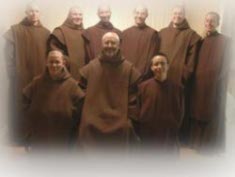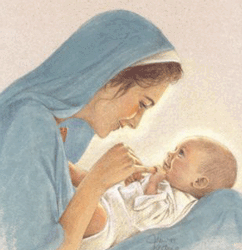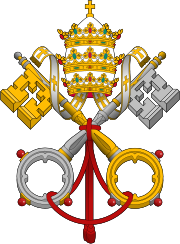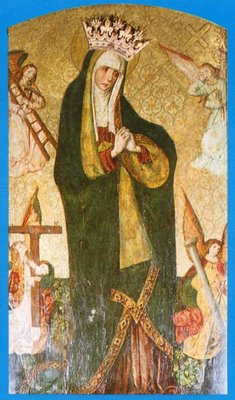 DEVOTION CORNER
DEVOTION CORNER
"On the Fourth Dolour - Of the Meeting of Mary with Jesus, when He was going to Death"
fragments from "The Glories of Mary" by St. Alphonsus Liguori
Saint Bernardine says, that to form an idea of the greatness of Mary's grief in losing her Jesus by death, we must consider the love that this Mother bore to her Son. All mothers feel the sufferings of their children as their own. Hence, when the Canaanitish woman entreated our Saviour to deliver her daughter from the devil that tormented her, she asked Him rather to pity her, the mother, than her daughter:"Have mercy on me, O Lord, Thou Son of David, my daughter is grievously troubled by a devil"Matt. xv.22. But what mother ever loved her son as Mary loved Jesus? He was her only Son, reared amidst so many troubles; a most amiable Son, and tenderly loving His Mother; a Son who, at the same time that He was her Son, was also her God, who had come on earth to enkindle in the hearts of all the fire of Divine love, as He Himself declared: "I am come to cast fire on the earth, and what will I but that it be kindled?"Luke xii.49. Let us only imagine what a flame he must have enkindled in that pure heart of His holy Mother, void as it was of every earthly affection. In fine, the Blessed Virgin herself told Saint Bridget , 'that love had rendered her heart and that of her Son but one'. That blending together of Servant and Mother, of Son and God, created in the heart of Mary a fire composed of a thousand flames. But the whole of this flame of love was afterwards, at the time of the Passion, changed into a sea of grief, when Saint Bernardine declares, 'that if all the sorrows of the world were united, they would not equal that of the glorious Virgin Mary. Yes, because, as Richard of St. Lawrence writes, 'the more tenderly this Mother loved, so much the more deeply was she wounded.' The greater was her love for Him, the greater was her grief at the sight of His sufferings; and especially when she met her Son, already condemned to death, and bearing His cross to the place of punishment. This is the fourth sword of sorrow which we have this day to consider. The Blessed Virgin revealed to Saint Bridget, that when the time of the Passion of our Lord was approaching, her eyes were always filled with tears, as she thought of her beloved Son, whom she was about to lose on earth, and that the prospect of that approaching suffering caused her to be seized with fear, and a cold sweat to cover her whole body. Behold, the appointed day at length came, and Jesus, in tears, went to take leave of His Mother, before going to death. Saint Bonaventure, contemplating Mary on that night, says: "Thou didst spent it without sleep, and whilst others slept thou didst remain watching." In the morning the disciples of Jesus Christ came to the afflicted Mother, the one to bring her one account, the other another; but all were tidings of sorrow, verifying in her the prophecy of Jeremias: "Weeping, she hath wept in the night, and her tears are on her cheeks; there is none to comfort her of all them that were dear to her." Some then came to relate to her the cruel treatment of her Son in the house of Caiphas; and others, the insults He had received from Herod. Finally - to come to our point, I emit all the rest - Saint John came, and announced to Mary, that the most unjust Pilate had already condemned Him to die on the cross. I say the most unjust Pilate; for, as Saint Leo remarks, 'This unjust judge condemned Him to death with the same lips with which he had declared Him innocent.... Mary goes with St. John, and by the blood with which the way is sprinkled, she perceives that her Son had already passed. This she revealed to Saint Bridget: 'By the footsteps of my Son, I knew where He had passed: for along the way the ground was marked with blood.' Saint Bonaventure represents the afflicted Mother taking a shorter way, and placing herself at the corner of a street, to meet her afflicted Son as He was passing by. 'The most sorrowful Mother, met her most sorrowful Son'. While Mary was waiting in that place, how much must she have heard said by the Jews, who soon recognised her, against her beloved Son, and perhaps even words of mocking against herself. Alas, what a scene of sorrows then presented itself before her! - the nails, the hammers, the cords, the fatal instruments of the death of her Son, all of which were borne before Him. And what a sword must the sound of that trumpet have been to her heart, which proclaimed the sentence pronounced against her Jesus! But behold, the instruments, the trumpeter, and the executioners, have already passed; she raised her eyes, and saw, O God! a young man covered with blood and wounds from head to foot, a wreath of thorns and two heavy beams on His shoulders. She looked at Him and hardly recognised Him, saying, with Isaias "and we have seen Him, and there was no slightliness."Isa liii. 2 Yes, for the wounds, the bruises, and the clotted blood, gave Him the appearance of a leper:"we have thought Him as it were a leper,"Isa liii. 4 so that He could no longer be known: "and His look was, as it were hidden and despised; whereupon we esteemed Him not."Isa. liii.3. But at length love revealed Him to her, and as soon as she knew that it indeed was He, ah what love and fear must then have filled her heart! as Saint Peter of Alcantara says in his meditations. On the one hand she desired to behold Him, and on the other she dreaded so heart-rending a sight. At length they looked at each other. The Son wiped from His eyes the clotted blood, which, as it was revealed to St Bridget, prevented Him from seeing, and looked at His Mother, and the Mother looked at her Son.....Mary at the sight of her Son, on His way to Calvary, did not faint...nor did she die, for God reserved her for greater grief: but though she did not die, her sorrow was enough to have cause her a thousand deaths. The Mother would have embraced her Son, as St Anselm says, but the guards thrust her aside with insults, and urged forward the suffering Lord; and Mary followed Him. Ah, holy Virgin, whither goest thou? To Calvary. And canst thou trust thyself to behold Him, who is thy life, hanging on a cross?"And thy life shall be, as it were, hanging before thee."Deut xxviii. 86...But although the sight of her dying Jesus was to cost her such bitter sorrow, the loving Mary will not leave Him: the Son advanced, and the Mother followed, to be also crucified with her Son, as the Abbot William says: 'the Mother also took up her cross and followed to be crucified with Him'. 'We even pity wild beasts' as St John Chrysostom writes; and did we see a lioness following her cub to death, the sight would move us to compassion. And shall we not also be moved to compassion on seeing Mary follow her immaculate Lamb to death? Let us, then, pity her, and let us also accompany her Son and herself, by bearing with patience the cross which our Lord imposes on us. Saint Chrysostom asks why Jesus Christ, in His other sufferings, was pleased to endure them alone, but in carrying His cross was assisted by the Cyrenean? He replies, that it was 'that thou mayest understand that the cross of Christ is not sufficient without thine.'
PRAYER
Ah, immaculate Virgin, from thee do I hope for help to accept and to bear all the crosses with patience. Amen.
In attempt to improve the structure of the blog let me arrange all devotional posts under the name of 'Devotion corner'.
skip to main |
skip to sidebar

This is the Carmelite shield of the Ancient Observance. The palm and the lily signifies the first saints of the order: St. Angelus of Sicily (signified by the palm of martyrdom) and St. Albert of Trapani (signified by the lily). Six pieces of spiritual armour are described in the rule of the Order; the cincture is the symbol of purity, indispensable for one who desires to reach the holy mountain of the vision of God: "Blessed are the pure of heart, for they shall see God". The corselet which protects the vital parts of the body represents good thoughts: "Holy thoughts will protect you". The breastplate which covers the whole body represents justice, a well regulated life, the observance of the commandments and duties of daily life. The shield is faith; for a living faith is the best safeguard for the spiritual life. The helmet symbolizes hope, confidence in God, which gives us the right to walk with freedom and confidence. Finally, the sword indicates conversation with God which as a double edge blade comes to our aid and defends us in all our difficulties.

Mount Carmel, Carmelite Monastery - beautiful statue of Our Lady. Picture credit: Karmel im Heiligen Land

Carmel in Toledo - Under Our Lady's mantle - St Elijah in Carmelite habit in company of other prophets (lower left panel). Picture credit: Karmel im Heiligen Land
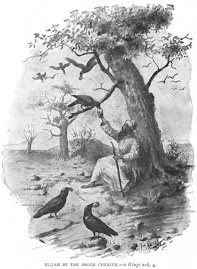
1Kings 17:4 - Elijah by the brook of Cherith
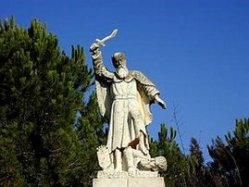
Elijah statue in front of Carmelite Monastery on Mt Carmel









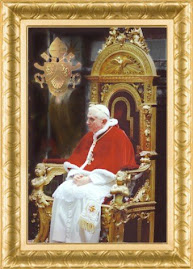


This blog is to propagate genuine Catholic devotions in the spirit of Traditional Carmel by providing texts useful for spiritual readings and meditations. "The devil knows that he has lost the soul that perseveringly practices mental prayer" - St Teresa of Avila. "For we preach not ourselves, but Jesus Christ our Lord; and ourselves your servants through Jesus" (2Cor 4:5). Soli Deo honor et gloria. The blog is lovingly dedicated to the Infant Jesus of Prague and under His Patronage
THE INFANT JESUS OF PRAGUE
Search This Blog
ABOUT CARMELITES

This is the Carmelite shield of the Ancient Observance. The palm and the lily signifies the first saints of the order: St. Angelus of Sicily (signified by the palm of martyrdom) and St. Albert of Trapani (signified by the lily). Six pieces of spiritual armour are described in the rule of the Order; the cincture is the symbol of purity, indispensable for one who desires to reach the holy mountain of the vision of God: "Blessed are the pure of heart, for they shall see God". The corselet which protects the vital parts of the body represents good thoughts: "Holy thoughts will protect you". The breastplate which covers the whole body represents justice, a well regulated life, the observance of the commandments and duties of daily life. The shield is faith; for a living faith is the best safeguard for the spiritual life. The helmet symbolizes hope, confidence in God, which gives us the right to walk with freedom and confidence. Finally, the sword indicates conversation with God which as a double edge blade comes to our aid and defends us in all our difficulties.

Mount Carmel, Carmelite Monastery - beautiful statue of Our Lady. Picture credit: Karmel im Heiligen Land
Carmelites are one of four mendicant religious Orders, originally founded in ancient Palestine with spirituality drawn from the imitation of the holy Prophet Elijah and zealous veneration of the Blessed Virgin Mary. The Order is dedicated to Our Lady, she is particularly honoured and venerated by Carmelites and the life of Carmelite should be focused on imitation of Mary. Devotion of the Brown Scapular, Mary's habit, caused Carmelites to be known as "Brothers of the Blessed Virgin Mary of Mount Carmel", to which Popes and Bishops attached indulgences. The oldest preserved constitution of the Order, established during General Chapter of Barcelona (1324), tells us that from the times of the holy Prophets, Elijah and Elisha, devout hermits lived continuously on Mt. Carmel, sought this holy mountain and loved its solitude in order to give their minds over to the contemplation of heavenly things; they built a chapel there in honor of the Virgin and thus deserved to be called the Brothers of Our Lady of Mount Carmel, a name recognized by Popes. St. Albert gave them a rule which was approved and the Carmelites, as we know them today, are successors of these holy hermits. Therefore, from its origin, their spirituality has been founded on these two specific elements, an imitation of the holy Prophet Elijah and veneration of the Blessed Virgin Mary (from Bl Titus Brandsma - "Lectures on Carmelite Spirituality" - Carmelnet).

Carmel in Toledo - Under Our Lady's mantle - St Elijah in Carmelite habit in company of other prophets (lower left panel). Picture credit: Karmel im Heiligen Land
Therefore, since the beginning of this blog established to promote Carmelite spirituality, special care has been taken to dedicate meditations of Saturday - day of Our Lady in Church's tradition - in honour and veneration of the Blessed Virgin, the ever glorious Patroness of all Carmelites.
ST ELIJAH AND CARMELITE SPIRITUALITY

1Kings 17:4 - Elijah by the brook of Cherith
In The Book of the First Monks, a medieval Carmelite work on the spirit of the order, the following teaching stands out: "The goal of this life is twofold. One part we acquire, with the help of divine grace, through our efforts and virtuous works. This is to offer God a pure heart, free from all stain of actual sin. We do this when we are perfect and in Cherith, that is, hidden in that charity of which we read: "Charity covers all sins " (Prov. 10:12 ). God desired Elijah to advance thus far when he said to him: "Hide yourself by the brook Cherith " (1 Kings 17:3-4). The other part of the goal of this life is granted us as the free gift of God: namely, to taste somewhat in the heart and to experience in the soul, not only after death but even in this mortal life, the intensity of the divine presence and the sweetness of the glory of heaven. This is to drink of the torrent of the love of God. God promised it to Elijah in the words: "You shall drink from the brook. " It is in view of this double end that the monk ought to give himself to the eremitic and prophetic life" (after Carmelites.com).
Prophet Elijah testimony: "I have burned with zeal for the Lord God of hosts" (1 Kings 19:9) - has become spiritual motto of Carmelites
Prophet Elijah testimony: "I have burned with zeal for the Lord God of hosts" (1 Kings 19:9) - has become spiritual motto of Carmelites
Prophet Elijah victory at Mt Carmel over idolatrous prophets of Baal (1Kings 18)

Elijah statue in front of Carmelite Monastery on Mt Carmel
The greatest achievement of Elijah's life was his victory over the priests of Baal at Mt. Carmel. Having heard that the other prophets of Yahwh were also persecuted, he requested King Ahab to gather the people of Israel, the 450 priests of Baal, and the 400 prophets of Ashtaroth on Mt. Carmel.
Then he asked Israel the famous question of 1 Kings 18:21: "How long will you waver between two opinions? If the LORD is God, follow him; but if Baal is God, follow him", meaning, "How long will ye be undecided as to whether ye shall follow Yahwh or Baal?" The people remaining silent.
He invited the priests of Baal to a contest, proposing that he and they should each build an altar and lay a burnt offering thereon, and that the God who should send down fire from heaven to consume the offering should be accepted as the true God. After various unsuccessful attempts to get a favorable answer had been made by the prophets of Baal, while they were ridiculed with subtle irony by Elijah, Elijah prayed, and Yahwh sent fire from heaven to consume his offering. Yahwh was recognized by Israel, and the priests of Baal were slain by the people near the brook Kishon (1 Kings 18:17-40).
Then he asked Israel the famous question of 1 Kings 18:21: "How long will you waver between two opinions? If the LORD is God, follow him; but if Baal is God, follow him", meaning, "How long will ye be undecided as to whether ye shall follow Yahwh or Baal?" The people remaining silent.
He invited the priests of Baal to a contest, proposing that he and they should each build an altar and lay a burnt offering thereon, and that the God who should send down fire from heaven to consume the offering should be accepted as the true God. After various unsuccessful attempts to get a favorable answer had been made by the prophets of Baal, while they were ridiculed with subtle irony by Elijah, Elijah prayed, and Yahwh sent fire from heaven to consume his offering. Yahwh was recognized by Israel, and the priests of Baal were slain by the people near the brook Kishon (1 Kings 18:17-40).
TWO CARMELITE ORDERS - TWO BRANCHES OF THE SAME TRUNK

Looking at Carmel from above, its two branches are united at their summits. Despite the separation which exists on the trunk, the two branches intermingle their foliage and blossoms without our being able to distinguish those which belong to the one from those which belong to the other. The blind singer of Rennes, Ven. John of St. Samson, does not have a different melody from that of the inspired singer imprisoned in the Carmel of Toledo, because both repeat what the Institutio primorum monachorum had inculcated in the Carmelites of the first centuries, namely, that all Carmelites, Brothers and Sisters of the Order of Our Lady of Mt. Carmel, in order to be faithful to their vocation should do their very utmost to go, under the guidance of the saintly hermit and prophet Elijah, across the desert of this life up to the Mt. Horeb of the vision of God, strengthened by the heavenly nourishment which is shown on the altar. (Bl Titus Brandsma, Lectures)

PRAYER TO THE HOLY GHOST - St MARY OF JESUS CRUCIFIED, OCD
Holy Spirit, inspire me.
Love of God, consume me.
Along the true road, lead me.
Mary my Mother, look upon me.
With Jesus, bless me.
From all evil, from all illusion,
from all danger, preserve me.
Source of peace, Light,
come and enlighten me.
I am hungry, come and nourish me.
I am thirsty, come and quench my thirst.
I am blind, come and give me light.
I am poor, come and enrich me.
Love of God, consume me.
Along the true road, lead me.
Mary my Mother, look upon me.
With Jesus, bless me.
From all evil, from all illusion,
from all danger, preserve me.
Source of peace, Light,
come and enlighten me.
I am hungry, come and nourish me.
I am thirsty, come and quench my thirst.
I am blind, come and give me light.
I am poor, come and enrich me.
About Me

- Jay
- 'Jay' stands for the phonetics of my first name initial 'J', as I have chosen anonymity in blogging. I am 'cradle' Roman Catholic, happy wife, mother and grandmother. I am professed Discalced Carmelite tertiary now, who loves and respects Our Lady of Mount Carmel and Holy Tradition of the RC Church - "Therefore, brethren, stand fast; and hold the traditions which you have learned, whether by word, or by our epistle" (2Thes 2:14), and: "Even if Catholics faithful to Tradition are reduced to a handful, they are the ones who are the true Church of Jesus Christ” (St. Athanasius, AD 373). In my devotion to Church's Tradition and Tridentine Mass I am with the Latin Mass Society of England and Wales and in union with the Holy Roman Catholic Church. In conclusion, the aim of this blog is to present and propagate traditional Catholic devotions, piety and Carmelite Spirituality in the richness of Tradition. All my efforts are aimed to help to preserve Catholic identity. The idea of this project is entirely private and comes from my own convictions and understanding of Catholicism.
BLOG ARCHIVE
-
▼
2006
(453)
-
▼
September
(59)
- SCRIPTURE CORNERQUEEN OF PROPHETS, PRAY FOR US!Our...
- PRAYER TO OUR LADY, QUEEN OF ANGELSRemedy against ...
- SCRIPTURE CORNER CHARITY AND THE CONTRARY VICES fr...
- SCRIPTURE CORNER FOR MY COUNTLESS SINSfragments fr...
- SAINTS OF CARMEL TEACHINGMAXIMS OF ST TERESA OF AV...
- SCRIPTURE CORNER FOR THE SALVATION OF THE WORLDfra...
- SAINTS OF CARMEL TEACHINGMAXIMS OF ST TERESA OF AV...
- SAINTS OF CARMEL TEACHINGMAXIMS OF ST TERESA OF AV...
- SAINTS OF CARMEL TEACHINGMy friend sent me these b...
- WISDOM OF THE SAINTS The fragment below appeared o...
- SCRIPTURE CORNER"When Jesus went into the house of...
- SCRIPTURE CORNER God's grace with usIn today's Col...
- OUR LADY of RANSOM or OF MERCY (Her Order’s establ...
- SIXTEENTH SUNDAY AFTER PENTECOST
- SCRIPTURE CORNERQUEEN OF PATRIARCHS, PRAY FOR US W...
- ST THECLA Biographical sketch and comments after ...
- ST. THOMAS OF VILLANOVABiographical sketch after P...
- SCRIPTURE CORNER ALMSGIVINGEcclesiasticus gives us...
- SAINTS OF CARMEL TEACHINGSt. Teresa of Avila - "W...
- WISDOM OF THE SAINTSUNIFORMITY TO GOD'S WILLmedita...
- SAINTS OF CARMEL TEACHINGSt. Teresa of Avila "Way ...
- WISDOM OF THE SAINTSUNIFORMITY TO GOD'S WILLmedita...
- SAINTS OF CARMEL TEACHINGSt. Teresa of Avila "Way ...
- WISDOM OF THE SAINTSUNIFORMITY TO GOD'S WILLmedita...
- WISDOM OF THE SAINTSUNIFORMITY TO GOD'S WILLmedita...
- SAINT ALBERT, lawgiver of the Carmelite orderThe F...
- WISDOM OF THE SAINTSUNIFORMITY TO GOD'S WILLmedita...
- SAINT JOSEPH of CUPERTINO Franciscan Priest (1603-...
- "LITTLE FLOWERS OF ST.FRANCIS" fragments CHAPTER...
- Fifteenth Sunday after Pentecost
- SCRIPTURE CORNER Saturday Devotion to Our LadyQuee...
- SAINTS OF CARMEL TEACHINGfragments from the "Way o...
- SAINT CATHERINE of GENOA Widow (1447-1510)Saint C...
- SAINTS OF CARMEL TEACHINGfragments from the "Way o...
- SAINTS OF CARMEL TEACHINGfragments from the "Way o...
- DEVOTION CORNER "On the Seventh Dolour - The Buria...
- The EXALTATION of the HOLY CROSS of OUR LORD JESUS...
- DEVOTION CORNER - "On the Sixth Dolour - The pierc...
- SAINTS OF CARMEL TEACHINGfragments from the "Way o...
- Which order is better?A Franciscan and Jesuit were...
- Feast of the Holy Name of Mary
- DEVOTION CORNER"On the Fifth Dolour - Of the Death...
- SAINTS OF CARMEL TEACHINGfragments from the "Way o...
- DEVOTION CORNER "On the Fourth Dolour - Of the Mee...
- DEVOTION CORNER "On the Third Dolour - Of the Loss...
- FOURTEENTH SUNDAY AFTER PENTECOST. fragments from ...
- SCRIPTURE CORNER - The other nine, where they are?...
- DEVOTION CORNER"On the Second Dolour - Of the Flig...
- SCRIPTURE CORNER NATIVITY OF THE BLESSED VIRGIN MA...
- The NATIVITY of the BLESSED VIRGIN (ca. 15 B.C.)Sp...
- SINCERITYfragments from "Divine Intimacy" by Fr G...
- GRATITUDE fragments from "Divine Intimacy" by Fr G...
- SCRIPTURE CORNERA FATHER'S PITYWe are all sinners,...
- SCRIPTURE CORNERGOD, THE ALMIGHTYChrist said one d...
- THIRTEENTH SUNDAY AFFTER PENTECOSTAfter "Divine In...
- SCRIPTURE CORNERConsolatrix afflictorum - Ora pro ...
- PERFECT JUSTICE from "Divine Intimacy" by Fr Gabri...
- "Dark night of the soul" - St John of the Cross CH...
- September - Month of the Holy Cross
-
▼
September
(59)
Traditional Rite Discalced Carmelite Nuns in Valparaido, Nebraska
TRADITIONAL RITE THIRD ORDER CARMELITES

Traditional Latin Rite Third Order of Carmelites of Ancient Observance from Campos, Brasil was originally established on 13 May 1752. Their spiritual director is Rev. Father Everaldo Bon Robert, who is also O. Carm Tertiary. The Order numbers 150 members, among them 15 priests, 3 religious brothers of “conventual life” plus some associated Regular Third Order Sisters. The Order is under jurisdiction of the Personal Apostolic Administration of St. John Mary Vianney, which was created by the Holy See in 2002 for the Traditional Catholics of the Latin Rite in Brazil under administration of the Bishop Fernando Areas Rifan. In their church, the Traditional Latin Mass is the only Mass celebrated and every member of the Order pray Saturday's Rosary fervently in honour of the Queen and Mother of Carmel to keep them always in such a special grace. Third Order meetings take place on every 2nd Sunday of the month, and all Tertiaries, brothers and sisters, wear full Carmelite habit (as featured in the picture above).
Church of Our Lady of Mt Carmel in Campos - blog and news
Flos Carmeli Vitis Florigera blog of the Order
Short history of the Society of St John Vianney in Campos, Brazil
Church of Our Lady of Mt Carmel in Campos - blog and news
Flos Carmeli Vitis Florigera blog of the Order
Short history of the Society of St John Vianney in Campos, Brazil
ADORATION OF THE BLESSED SACRAMENT DEVOTION

DEVOTION TO THE HOLY SACRIFICE OF THE MASS

DEVOTION TO THE MOST HOLY ROSARY OF THE BLESSED VIRGIN MARY
Why we should meditate on Our Lady's titles and invocations of Loreto Litany
This litany to the Blessed Virgin Mary was composed during the Middle Ages. The place of honor it now holds in the life of the Church is due to its faithful use at the shrine of the Holy House at Loreto. It was definitely approved by Sixtus V in 1587, and all other Marian litanies were suppressed, at least for public use. Its titles and invocations set before us Mary's exalted privileges, her holiness of life, her amiability and power, her motherly spirit and queenly majesty. The principle that has been followed in their interpretation is the one enunciated by the same Pius IX: "God enriched her so wonderfully from the treasury of His divinity, far beyond all angels and saints with the abundance of all heavenly gifts, that she . . .should show forth such fullness of innocence and holiness, than which a greater under God is unthinkable and which, beside God, no one can even conceive in thought." Hence, whatever virtue and holiness is found in angels and saints must be present in Mary in an immeasurably higher degree.
Reflection on the titles of the litany will unfold before us the grand picture of our heavenly Mother, even though we know only little about her life. We will also come to see why Mary's example, guidance, and help is the need of the hour (from Intermirifica, Litany of Loreto).
Reflection on the titles of the litany will unfold before us the grand picture of our heavenly Mother, even though we know only little about her life. We will also come to see why Mary's example, guidance, and help is the need of the hour (from Intermirifica, Litany of Loreto).
DEVOTION TO THE PASSION OF OUR LORD JESUS CHRIST
All the Saints achieved sanctity by meditating upon the Passion of Our Lord Jesus Christ. By this devotion, we have an irresistible and proven method to advance in our love for Our Divine Master as well as overcoming all our personal faults. The Passion of Jesus is also a treasure-house whose wealth will never suffer devaluation and obtains for us from the Eternal Father, Who cannot resists this devotion, all of those graces essential for our salvation as well as to that of others. This is the reason for which the Crucifix occupies a place of Honour upon our Altars, our Churches, our tombstones, in Christian bedrooms, as well as in the households of Christian families.
"One thing only I do know", says St Paul, "and that is Jesus and Jesus Crucified" (1 Cor 2:2).
And St Augustine: "I know of no remedy more effective against the sins of the flesh (i.e. concupiscence) than the Passion of my Lord Jesus Christ".
Saint Bonaventure: "The Passion of Jesus dissolves in Divine Love even the most callous hearts of obstinate sinners".
Saint Albert the Great: "One gains more merits by meditating lovingly on the Passion than by scourging oneself most severely or by fasting on bread and water every day of one's life".
Always keep in mind the devotion of (King) Saint Louis to the Relics of the Passion. Saint Teresa of Avila began her spiritual ascent to high sanctity following a vision of Jesus after His Scourging and a glimpse of the "Ecce Homo"...behold also Saint Therese of The Child Jesus contemplating the Holy Face.
Second only to the Most Holy Sacrifice of the Mass, the merits of which are applied to our souls and which truly renews before us, albeit in an unbloody manner, the Infinite Sacrifice of the Lamb of God on Calvary, the Holy Hour of Reparation and the Way of the Cross consitute the most effective practices regarding the Devotion of the Most Holy Passion of Jesus.
"One thing only I do know", says St Paul, "and that is Jesus and Jesus Crucified" (1 Cor 2:2).
And St Augustine: "I know of no remedy more effective against the sins of the flesh (i.e. concupiscence) than the Passion of my Lord Jesus Christ".
Saint Bonaventure: "The Passion of Jesus dissolves in Divine Love even the most callous hearts of obstinate sinners".
Saint Albert the Great: "One gains more merits by meditating lovingly on the Passion than by scourging oneself most severely or by fasting on bread and water every day of one's life".
Always keep in mind the devotion of (King) Saint Louis to the Relics of the Passion. Saint Teresa of Avila began her spiritual ascent to high sanctity following a vision of Jesus after His Scourging and a glimpse of the "Ecce Homo"...behold also Saint Therese of The Child Jesus contemplating the Holy Face.
Second only to the Most Holy Sacrifice of the Mass, the merits of which are applied to our souls and which truly renews before us, albeit in an unbloody manner, the Infinite Sacrifice of the Lamb of God on Calvary, the Holy Hour of Reparation and the Way of the Cross consitute the most effective practices regarding the Devotion of the Most Holy Passion of Jesus.
The Way of the Cross Final Prayer - St Alphonsus Liquori
O God who for the world's redemption was pleased to be born, circumcised, rejected by the Jews, betrayed by the kiss of Judas, bound with chains, led like an innocent lamb to sacrifice, and shamefully presented before Annas, Caiphas, Pilate, and Herod, accused by false witnesses, beaten with whips, buffeted, insulted, spat upon, crowned with thorns, smitten with a reed, blindfolded, stripped of thy garments, fastened with nail to the cross and lifted high, reputed among thieves and made to drink vinegar, and wounded with a lance; O by these most sacred sufferings which unworthy as I am, I thus commemorate, and by Thy Holy Cross and death deliver me Lord from the pains of hell and deign to lead me where thou didst lead the penitent thief who was crucified by thy side; Thou, Who, with the Father and the Holy Ghost livest and reignest world without end. Amen
PRAYING ANGELUS

V. Angelus Domini nuntiavit Mariae.
R. Et concepit de Spiritu Sancto.
Ave, Maria...
V. Ecce ancilla Domini,
R. Fiat mihi secundum verbum tuum.
Ave, Maria...
V. Et Verbum caro factum est,
R. Et habitavit in nobis.
Ave, Maria......
V. Ora pro nobis, sancta Dei Genetrix,
R. Ut digni efficiamur promissionibus Christi.
Oremus:
Gratiam tuam, quaesumus,
Domine, mentibus nostris infunde;
ut qui, Angelo nuntiante,
Christi Filii tui incarnationem cognovimus,
per passionem eius et crucem
ad resurrectionis gloriam perducamur.
Per eumdem Christum Dominum nostrum.
R. Amen.
THE THREE GREAT HAIL MARY'S DEVOTION
"While St. Mechtilde was beseeching the glorious Virgin to assist her in her hour of death, Our Lady appeared to her and said: 'I will certainly. But I also want you to say three special Hail Mary's to me every day.
"'The first will be in honor of God the Father, Whose omnipotence raised my soul so high above every other creature that after God I have the greatest power in heaven and on earth. In the hour of your death I will use that power of God the Father to keep any hostile power far from you.
"''The second Hail Mary will be said in honor of the Son of God Who communicated His inscrutable wisdom to me. In the hour of your death I will fill your soul with the light of that wisdom so that all the darkness of ignorance and error will be dispelled.
"'The third Hail Mary will be in honor of God the Holy Spirit Who filled my soul with the sweetness of His love and tenderness and mercy. In your last hour I will then change the bitterness of death into divine sweetness and delight.' "
Pray these Great Hail Mary's Daily!!!
"'The first will be in honor of God the Father, Whose omnipotence raised my soul so high above every other creature that after God I have the greatest power in heaven and on earth. In the hour of your death I will use that power of God the Father to keep any hostile power far from you.
"''The second Hail Mary will be said in honor of the Son of God Who communicated His inscrutable wisdom to me. In the hour of your death I will fill your soul with the light of that wisdom so that all the darkness of ignorance and error will be dispelled.
"'The third Hail Mary will be in honor of God the Holy Spirit Who filled my soul with the sweetness of His love and tenderness and mercy. In your last hour I will then change the bitterness of death into divine sweetness and delight.' "
Pray these Great Hail Mary's Daily!!!

CHURCH MAGISTERIUM







